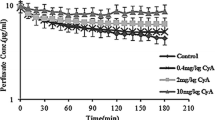Abstract
The antipyrine metabolic clearance rate (MCR) was studied in two groups of patients with similar degrees of cholestasis and hepatic damage, but differing mechanisms of cholestasis. The plasma disappearance rate of antipyrine in 18 patients with extrahepatic cholestasis and 11 patients with intrahepatic cholestasis was compared with that of two groups of control subjects without liver disease who were matched for age. Whereas no significant difference was observed for the antipyrine MCR between patients with extrahepatic cholestasis and their controls [30.7±11.2 (sd) as against 31.6±10.0 ml/min], the antipyrine MCR was significantly lower (P<0.001) in the patients with intrahepatic cholestasis than in their controls (16.2±4.5 vs 37.4±17.3 ml/min). These results suggest that cholestasisper se does not change the rate of metabolism of drugs by the liver. The decrease of antipyrine MCR in patients with intrahepatic cholestasis could be due to a reduced functional parenchymal mass related to some degree of hepatic necrosis.
Similar content being viewed by others
References
Andreasen PB, Ranek L, Statland BE, Tygstrup N: Clearance of antipyrine-dependence of quantitative liver function. Eur J Clin Invest 4:129–134, 1976
Branch RA, Herbert CM, Read AE: Determinants of serum antipyrine half-lives in patients with liver disease. Gut 14:569–573, 1973
Hepner GW, Vesell ES, Lipton A, Harvey HA, Wilkinson GR, Schenker S: Disposition of aminopyrine, antipyrine, diazepam and indocyanine green in patients with liver disease or on anticonvulsant drug therapy: Diazepam breath test and correlation in drug elimination. J Lab Clin Med 90:440–446, 1977
Miguet JP, Allemand H, Joanne C, Dhumeaux D: La clairance de l'antipyrine un test pour apprécier la fonction hépatique d'oxydation des médicaments. Etude au cours de la cirrhose. Nouv Presse Med 7:4209–4211, 1978
Carulli N, Manenti F, Ponz de Leon M, Ferrari A, Salvioli G, Gallo M: Alteration of drug metabolism during cholestasis in man. Eur J Clin Invest 5:455–462, 1975
Elfström J, Lindgren S: Disappearance of phenazone from plasma in patients with obstructive jaundice. Eur J Clin Pharmacol 7:467–471, 1974
Andreasen PB, Greisen G: Phenazone metabolism in patients with liver disease. Eur J Clin Invest 6:21–26, 1976
Galizzi J, Long RG, Billing BH, Sherlock S: Assessment of the [14C]aminopyrine breath-test in liver disease. Gut 19:40–45, 1978
Breimer DD, Zilly W, Richter E: Pharmacokinetics of hexobarbital in acute hepatitis and after apparent recovery. Clin Pharmacol Ther 18:433–440, 1975
Burnett DA, Barak AJ, Tuma DJ, Sorrel MF: Altered elimination of antipyrine in patients with acute viral hepatitis. Gut 17:341–344, 1976
McHorse TS, Wilkinson GR, Johnson RF, Schenker S: Effect of acute viral hepatitis in man on the disposition and elimination of meperidine. Gastroenterology 68:775–780, 1975
Williams RL, Blaschke TF, Meffin PJ, Melmon KL, Rowland M: Influence of viral hepatitis on the disposition of two compounds with high hepatic clearance: Lidocaine and indocyanine green. Clin Pharmacol Ther 20:290–299, 1976
Crooks J, O'Malley K, Stenvenson IH: Pharmacokinetics in the elderly. Clin Pharmacokinet 1:280–296, 1976
Conney AH: Pharmacological implications of microsomal enzyme induction. Pharmacol Rev 19:317–366, 1967
Levi AJ, Sherlock S, Wacker D: Phenylbutazone and isoniazid metabolism in patients with liver disease in relation to previous drug therapy. Lancet 1:1275–1279, 1968
Prescott LF, Adjepon-Yamoah KK, Roberts E: Rapid gasliquid chromatographic estimation of antipyrine in plasma. J Pharm Pharmacol 25:205–207, 1973
Siegel S: Nonparametric Statistics for the Behavioral Sciences. New York, McGraw-Hill Book, 1956
Vesell ES, Lee CJ, Passananti GT, Shively CA: Relationship between plasma antipyrine half-lives and hepatic microsomal drug metabolism in dogs. Pharmacology 10:317–328, 1973
Vuitton D, Miguet JP, Camelot G, Delafin C, Joanne C, Bechtel P, Gillet M, Carayon P: Relationship between metabolic clearance rate of antipyrine and hepatic microsomal drug-oxidizing enzyme activities in man without liver disease. Gastroenterology 80:112–118, 1981
Miguet JP, Vuitton D, Thebault-Lucas A, Joanne C, Dhumeaux D: Spironolactone and enzyme induction in patients with alcoholic cirrhosis. Gastroenterology 78:996–1000, 1980
Soberman R, Brodie BB, Levy BB, Axelrod J, Hollander V, Steele JM: The use of antipyrine in the measurement of total body water in man. J Biol Chem 179:31–42, 1949
Brodie BB, Axelrod J: The fate of antipyrine in man. J Pharmacol Exp Ther 98:97–104, 1950
Vesell ES, Passananti GT, Glenwright PA, Dvorchik BH: Studies on the disposition of antipyrine, aminopyrine and phenacetin using plasma, saliva, and urine. Clin Pharmacol Ther 18:259–272, 1975
Welch RM, Deangelis RL, Wingfield M, Farmer TW: Elimination of antipyrine from saliva as a measure of metabolism in man. Clin Pharmacol Ther 18:249–258, 1975
Huffman DH, Shoeman DW, Azarnoff DL: Correlation of the plasma elimination of antipyrine and the appearance of 4-hydroxyantipyrine in the urine of man. Biochem Pharmacol 23:197–201, 1974
Shand DG: Drug disposition in liver disease. N Engl J Med 296:1527–1528, 1977
Klotz U, Avant GR, Hoyumpa A, Schenker S, Wilkinson GR: The effect of age and liver disease on the disposition and elimination of diazepam in adult man. J Clin Invest 55:347–359, 1975
Doshi J, Luisada-Opper A, Leevy CM: Microsomal pentobarbital hydroxylase activity in acute viral hepatitis. Proc Soc Exp Biol Med 140:492–495, 1972
Schoene B, Fleischmann RA, Remmer H, Von Oldershausen HF: Determination of drug metabolizing enzymes in needle biopsies of human liver. Eur J Clin Pharmacol 4:65–73, 1972
Denk H, Eckerstorfer R, Rohr HP: The endoplasmic reticulum of the rat liver cell in experimental mechanical cholestasis. Correlated biochemical and ultrastructural-morphometric studies on structure and enzymes composition. Exp Mol Pathol 26:193–203, 1977
Pirttiaho H: Liver size in evaluating drug metabolizing capacity in man. Clin Pharmacol Biopharmacol 17:271–276, 1979
Hepner GW, Vesell ES: Quantitative assessment of hepatic function by breath analysis after oral administration of [14C]aminopyrine. Ann Intern Med 83:632–638, 1975
Author information
Authors and Affiliations
Rights and permissions
About this article
Cite this article
Miguet, J.P., Vuitton, D., Deschamps, J.P. et al. Cholestasis and hepatic drug metabolism. Digest Dis Sci 26, 718–722 (1981). https://doi.org/10.1007/BF01316861
Received:
Revised:
Accepted:
Issue Date:
DOI: https://doi.org/10.1007/BF01316861




